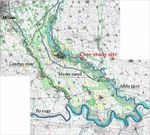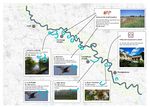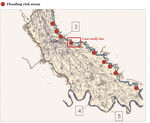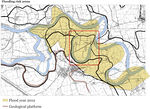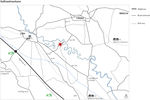Green Infrastructure 2014 Group N - Case Study 5
---> back to group page working group N
Bastia farms, Cavenago d'Adda, Lodi, Italy
| Name | Bastia farms | |
| Country | Italy | |
| City | Cavenago d'Adda | |
| Authors | Barbara Boschiroli | |
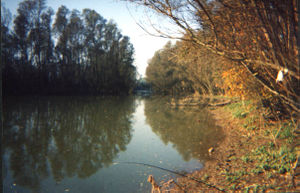
| ||
|
| ||
Rationale: Why is this case interesting?
The area is placed along the river Adda, in the south of Lodi town . The area is actually inside an old branch of the river and is dedicated to the agriculture production. The context is high relevant from different point of views: -for the environment, there are a lot of wetlands, some haunting reserves, rich river vegetation, beaches, banks and dykes -for the economy, high agriculture use direct to cultivate mais and grass for cow farms to produce the milk in the Grana Padano DOP cheese network -for the culture, there are some old urban villages with churches, villas, mills and farms The area is next to the current river course and is submitted to several flooding episodes during all the seasons in case of abundant rain. The area is formed by rural active fields, corn and grass, two farms, for cows and milk, and a private building, which was the old river camp of the municipality.
Author's perspective
I am a landscape architect. I took an architecture degree with a final project related with urban planning and landscaping on a neighborhood in Milan. I then worked in a landscape firm based in Milan where I developed several strategic projects and landscape projects, in urban and rural environment. I took two specialization courses about Water landscape and Public space at the UPC in Barcelona. At the moment I am working as a landscape consultant for different architects and engineer in the north of Italy. The site was an old family property where I spent most of my childhood.
Landscape and/or urban context of your case
- Biogeography, cultural features, overall character, history and dynamics
The Adda river is one of the main tributary to the Po, the main river in the north of Italy. The Adda borns in the Alps and crosses all the Lombardia region, passing through the Lecco lake, arrives in the flat area of the Pianura Padana. The Adda river is protected by two regional parks: the North, between the lake and Lodi town, and the South one, from Lodi town to the Po river. The two parks differ for the context the river crosses by and for the river course's features. The case study belongs to the South park area, where the course of the river becomes wider and with a lot of meanders, due to its lower speed across the plain( pic. 1). This part of the plain is dominated by the Adda and the Lambro river courses and by numerous canals for irrigation. The ecologic structure is based on the water courses and on their vegetation areas. (pic.2) The South park is characterized by a series of dead branches beside the meanders. one of the most famous of them is the Soltarico branch, originated from the flood in the 1976 when the river skipped the Soltarico meander and these 7 km of the old bed river became a series of wetlands and islands. Beside the Soltarico reserve there are other 5 natural reserve dead branches (pic.3). These protected areas (Life EU network) are important for their flora and fauna habitats, rare in the plain around. Even though the importance of these reserves, the Adda South Park has not many touristic structures: there isn’t a continuous path networks on the banks, there aren’t refreshment areas or other structures that could improve the human attraction. The case study is placed in one dead river branch and is the only one not transformed in a protected area. The Pianura Padana region is defined by its highly developed and mechanized agriculture. The landscape is dominated by the rhythm of the rural productions, corn and forage for the milk cows, and by the presence of small towns, villages and isolated farms, some of them quite old. Each of these towns and villages has its own church and bell tower, so even when the corn reaches its maximum height, in the end of summer, you can easily orientate yourself looking for the nearest tower or church. The case study is located between two small villages: Cavenago d’Adda and Rubbiano, and it belongs to the municipality of Cavenago d’Adda. Cavenago d’Adda has almost 2500 inhabitants and is placed on the south of the Adda river, on the top of a river terrace, on a higher level than the case study.
- Illustrations
Analytical drawings
- Please use analytical drawing for visualising the conflicts/potentials of your site
- Analytical Drawings
Green Infrastructure benefits for this site
Look again at the multiple benefits of green infrastructure - what could be achieved in your site and which are most relevant?
Potential for multifunctionality
Green infrastructure has typically multiple functions. What could be achieved for your site in this respect?
Projective drawings
- How would you like this case to change in the near future? (in 1-2 years)
- you may add a short explanation here
- And how could it look like in 10-15 years?
- you may add a short explanation here
- Projective Drawings
Summary and conclusion
- 100 words approx.
Image Gallery
Please add further images/photos here
- Image Gallery
- Yourimage.jpg
your image text
- Yourimage.jpg
your image text
- Yourimage.jpg
your image text
- Yourimage.jpg
your image text
- Yourimage.jpg
your image text
- Yourimage.jpg
your image text
- Yourimage.jpg
your image text
- Yourimage.jpg
your image text
References
- please add your references here
About categories: You can add more categories with this tag: "", add your categories

